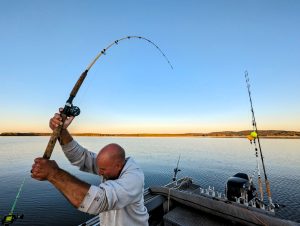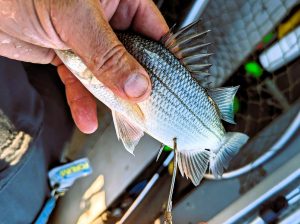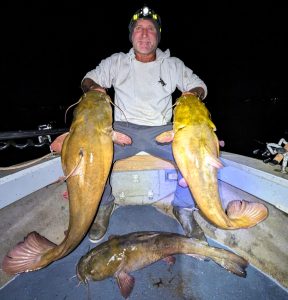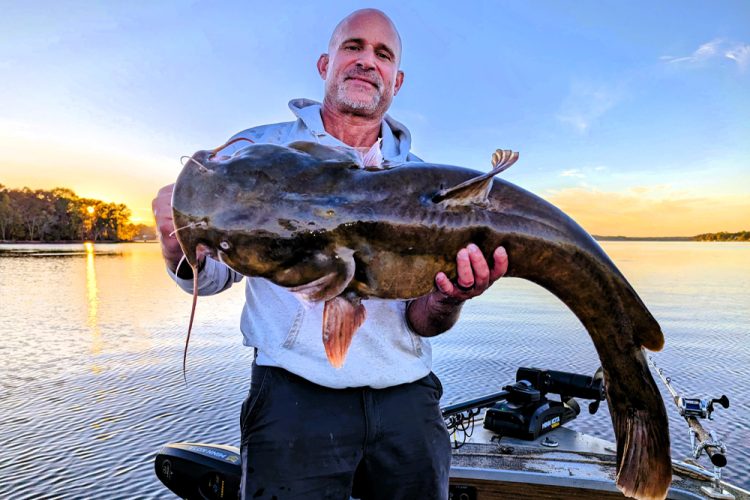Big flatheads like this will stack up along ledges and points where ample forage is located.
Flatheads Around the Clock
Story and photos by Terry Madewell
The flathead bite is strong in late-summer and fall but finding areas with plentiful forage is a must when targeting heavyweight fish.
When Brandon Miller finished his electronic scan of the ledge that dropped into deep water, he sported a wide-grinned smile, and backed it up with a prediction.
“We may not have to wait long for a bite; these flatheads are stacked up on this ledge, and forage is everywhere,” he said.

The normally conservative Miller isn’t prone to making such assessments unless the setup is ideal, so the flathead catfish situation had potential that afternoon. His description implied flatties were lined up as if in a chow line, and we were at the counter serving the food.
I had confidence that a bite from a flathead was in our short-term future, but I wasn’t prepared for multiple shovel-headed beasts to load on. Within minutes, we were both occupied fighting heavy flatheads. Then a third rod bowed, pulling drag, but neither of us was willing to leave our drag-squealing, already-hooked flatheads.
My thoughts that big flathead catfish are often loners made a course correction that afternoon. We were fishing North Carolina’s High Rock Lake, a terrific producer of blue catfish and one that truly excels for fat flatheads during late summer and fall. The big flatties are on the prowl, searching for forage, and tournament angler Brandon Miller from Gold Point, North Carolina loves to target them along deep channel ledges.
“The summer fishing is good but actually improves during the fall when the lake turns over,” Miller said. “When it does, the flathead fishing goes wild. But we catch them in good numbers even in late summer.
“The key to catching big flatheads right now is to hunt for them using your electronics and set up on spots where several big fish are marked, along with ample forage in the area,” he said. “It’s no different than most times of the year in that big catfish are going to be found around areas where forage concentrates. But this time of the year, and in the fall, the flatheads tend to congregate in good numbers.”
Flatheads gather along ledges and drops, but specific locations can vary depending on water-flow conditions.

“Forage movement impacts the localized hotspots, and locations vary throughout the year,” Miller said. “My key is locating areas with plenty of forage, then using electronics to pinpoint their position. It’s common for a lot of flatheads to gather in the same area, especially as we get into early fall. When I find fish clustered in an area, we can usually catch a few, then move only a short distance and put bait in front of new targets.”
Because flatheads tend to cluster in localized areas, Miller typically prefers fishing from an anchored setup.
“Drifting works, but I’ve found anchoring has been more effective when targeting big flatheads in this scenario,” he said.
Miller fishes multiple rigs, fan-casting them around the boat, and specifically targets some of the baits to be placed precisely where he marked fish, ideally, right in front of them.
“The fish are generally moving and feeding in that general area, so they’ll find the baits. But I make it as easy for them as possible,” he said.
Like most flathead anglers, he prefers live bait, with live white perch being his favorite summer through fall. But fresh, cut-bait produces, so he’ll use that, too.
“It’s not unusual to move a couple times to find really active flatties. But when I get on them, the bite can be good, and it’s not uncommon to catch two or three big flatheads quickly,” he said.
When a big flathead bites, Miller power-sets the hook. The flathead bite is a more gradual pull down than a bite from an aggressive blue catfish, and he’ll grab the rod, turn his back to the fish and move forward while forcefully setting the hook using two hands with help from his shoulder and back.

“It’s one thing to get a bite, but it’s crucial to power set the hook in a big flathead’s mouth,” he said. “Odds of landing him are much better.
“When one flathead loads on, it’s common for another to bite,” he continued. “The activity of one seems to make others active, and action can become frantic, even after a lengthy wait with no bites.”
Miller said he’s patient, but even if the setup looks good, after 60 to 90 minutes with no action, he makes a move.
Nocturnal fishing is excellent for flatheads during the summer and fall, and some anglers prefer the nighttime action.
“Similar situations occur at night and beginning late in the afternoon in lower light conditions,” Miller said. “When the flatties make a move toward shallower water is prime time. If I’m planning a late afternoon to midnight trip, a favorite way to fish for flatheads, I’ll make a position move close to sundown and target shallower water. It may not be far from where I set up by day, but at night, the flatheads move shallower to forage.”
Our trip was a late afternoon to after-dark sortie, and we found the action excellent right at sunset until dark, with occasional flurries after dark. Miller said nocturnal fishing along shallower ledges and points close to drops are prime targets because the flatheads have quick access from deep to shallow water. And forage species for flatheads move shallow on points at night.
Targeting big flatheads requires an angler to do their due diligence in finding big fish and forage in proximity, but it’s worth the time and effort when the potential is hooking multiple trophy flatheads. As Miller demonstrated, never doubt that flatheads will stack up in big numbers in localized areas, like they’re in a chow line, waiting to be served. When you see that on your sonar, fast action on fat flatties may be in your immediate future.
(Terry Madewell of Ridgeway, S.C., has been an outdoor communicator for nearly 50 years. He holds a degree in Wildlife and Fisheries Management and has a long career as a professional wildlife biologist/natural resources manager. He’s passionate about sharing outdoor adventures with others.)



